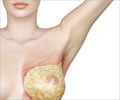
Though previous researchers have analyzed data on patients with this type of breast cancer, "there is not a strong consensus on whether or not having multifocal or multicentric breast cancer leads to higher recurrence rates," says Tiffany Tam, MD, an attending physician in the Radiation Oncology Department at Fox Chase Cancer Center, who will present new findings about this on October 30 at the American Society for Radiation Oncology's 54th Annual Meeting.
Tam led a team of Fox Chase physicians in a retrospective study designed to investigate for possible differences in outcomes. They found no statistically significant difference in overall survival or distant recurrence, where the cancer spreads to other organs or tissues. However, local recurrence—having cancer return to the same area from which it was surgically removed—occurred more than 2.5 times more often among patients with multifocal/multicentric disease, compared to patients with a single tumor.
Tam and her colleagues analyzed the medical records of 112 women who were treated for multifocal or multicentric breast cancer at Fox Chase between 1983 and 2010. They compared outcomes data from those patients with data from 263 women treated for unifocal disease during the same period. Patients from the two groups were matched by age, gender, and stage at diagnosis. The researchers incorporated data on hormone-receptor status, type of surgery, age, grade, stage, and other therapies into their analyses. Males and patients with ductal carcinoma in situ (DCIS), inflammatory breast cancer, or metastatic disease were all excluded from the study.
Overall survival rates and rates of distant recurrence were roughly equal between both groups. When the researchers accounted for all the variables, they found that multifocal or multicentric breast cancer patients were diagnosed with local recurrences about 2.6 times as often as patients with unifocal disease.
Tam says she was motivated to do the study after treating patients diagnosed with multifocal or multicentric disease. "For those patients who do not have any other indications for post-mastectomy radiation, I wondered whether or not multifocal or multicentric disease should be considered in the decision to offer radiation," she says.
Advertisement
"Even though this study suggests having multifocal or multicentric disease leads to increase local recurrence, we cannot draw definite conclusions, as this is just a single institutional small retrospective study. It's an additional factor that oncologists can consider," Tam adds. It's not clear whether or not patients with this type of disease have a more aggressive form of cancer or if they have some other risk factor that makes them more susceptible to developing multiple tumors.
Advertisement
Source-Eurekalert















